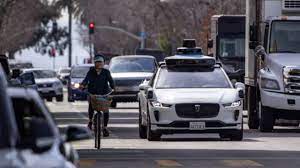
I Rode a Driverless Waymo in San Francisco — Smarter Than Most Human Drivers

 :
| Updated On: 09-Jun-2025 @ 3:14 pm
:
| Updated On: 09-Jun-2025 @ 3:14 pmSHARE
My first-ever ride in a driverless car, a Waymo robotaxi in San Francisco, was a thrilling blend of childish excitement and amazement. Before this, I had only seen autonomous vehicles in Hollywood films like Minority Report and I, Robot, never imagining I would be chauffeured by a robot. Since arriving in San Francisco, I eagerly awaited the chance to experience a Waymo ride around the city.
On a breezy June evening, after a packed day, we booked a Waymo through the Waymo One app, which resembles popular ride-hailing platforms. The vehicle was a Jaguar I-Pace, a battery-electric crossover by Jaguar Land Rover, distinct for having no driver in the front seat—off-limits to passengers. The car could accommodate up to four passengers, and the app provided usual features like estimated arrival times and route maps. My destination was Florella Noe, an Italian restaurant, arranged as a team outing.
The robotaxi arrived smoothly, easily recognized by its rooftop lidar domes packed with sensors and cameras. Unlocking the car through the app felt both strange and calming. Inside, cameras covered every angle, and the front passenger seat featured a touchscreen to control music and view trip details. The journey from the Intercontinental Hotel to the restaurant lasted about 15 minutes and was impressively smooth.
What struck me most was the car’s self-awareness—it carefully obeyed traffic signals, stopped patiently for pedestrians, and cautiously navigated complex city traffic without rushing or taking risks. The vehicle’s behavior felt more thoughtful and safer than many human drivers I have encountered. It signaled clearly, made gradual turns, and moved with precision.
Recent reports indicate Waymo cars are evolving rapidly beyond just technology, adopting human-like traits such as impatience at pedestrian crossings—sometimes inching forward before pedestrians fully clear the road. This evolution reflects the company’s efforts to make the robotaxis more assertive and predictable in traffic, addressing hesitancy that could confuse other drivers.
Despite advances, Waymo has faced challenges—since 2021, around 700 crashes involving its vehicles have been reported, some due to sensor failures or external factors like dogs. As the cars grow more assertive, concerns arise about safety in unpredictable, real-world situations where human judgment can be critical.
Turning to India, deploying driverless cars presents distinct obstacles. Indian roads are highly varied—ranging from highways to narrow lanes, often lacking clear lane markings, operational traffic signals, or standard signage. The mixed traffic environment includes pedestrians, animals, rickshaws, buses, and more, creating complex and unpredictable conditions for autonomous vehicles trained mostly on Western data.
Additionally, constant road construction and rerouting make maintaining up-to-date 3D maps challenging. Connectivity is another concern, as robotaxis depend on reliable cloud services for real-time updates, which may be hampered by patchy networks in some regions. Regulatory frameworks for driverless cars are still unclear in India, and widespread automation could disrupt millions of livelihoods in the driving profession, potentially causing social resistance.
Compared to countries like the US and China, India currently lacks large-scale homegrown autonomous vehicle technology companies, though major players like Tata and Mahindra are actively exploring the field. Opinions on self-driving cars vary widely: some fear job losses and dystopian futures, while others see them as safer, smarter alternatives that reduce human error.
For cities like San Francisco, where long commutes are common, autonomous vehicles are transformative—freeing up time for work or relaxation. Despite concerns about job displacement, the technology promises increased safety and efficiency. If autonomous cars can reliably navigate complex environments without distractions, a new era of transportation awaits exploration and growth.